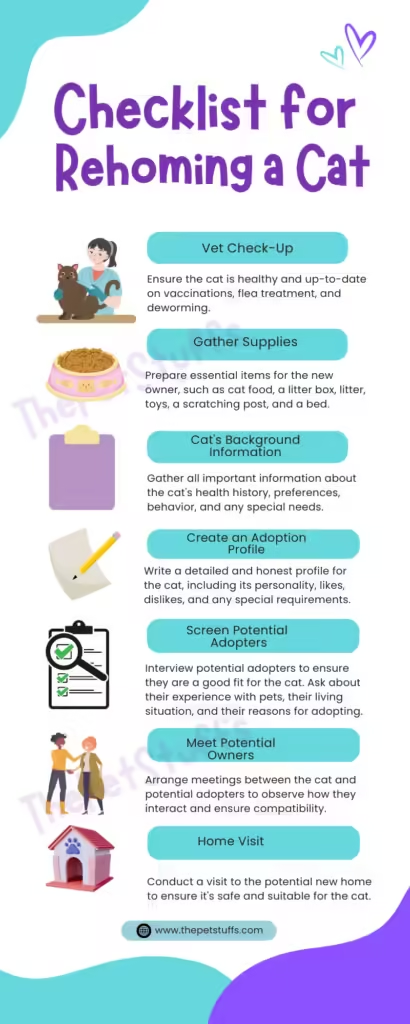Rehoming Cats – A Good Idea or A Bad Choice?
Rehoming a cat involves finding a new, suitable home for your feline friend when circumstances prevent you from keeping them. In this article, we will explore how to rehome a cat and provide practical tips on how to do it responsibly.
Additionally, we’ll address some frequently asked questions related to this process, ensuring that your cat finds a loving and safe environment.
Why Rehoming a Cat is Required?
Rehoming a cat is rarely an easy decision, but it is sometimes essential. Personal circumstances, such as moving to a non-pet-friendly area, allergies, or financial restraints, can all make adopting a cat more difficult. Sometimes, behavioral issues or the cat’s inability to get along with other pets or family members necessitate rehoming. Understanding how to rehome a cat can ensure they find a safe and loving environment where they can thrive.
Common Reasons for Rehoming a Cat
Rehoming a cat is a difficult decision for any pet owner, often driven by various personal, financial, or environmental factors.

Understanding the reasons behind how to rehome a cat can help ensure that the decision is made with the cat’s best interest in mind. Here are some common reasons why people might consider rehoming their cat:
Moving to a New Home: Relocating to a place that doesn’t allow pets or where pets are restricted in size or breed can force owners to consider rehoming. This is particularly common with international moves or moves to rental properties with strict pet policies.
Change in Household Dynamics: The arrival of a new baby, the introduction of new pets, or significant changes in the household (like divorce or a new partner with allergies) can create a challenging environment for the cat, leading owners to consider rehoming.
Inability to Afford Care: Keeping a cat requires continual expenses such as food, litter, grooming, and veterinarian care. If an owner is experiencing financial difficulties, they may be unable to give proper care and may believe that rehoming the cat to someone who can pay these expenses is the best solution.
Unexpected Veterinary Costs: Cats, like any pets, can develop health issues that require expensive treatments. The sudden burden of high medical costs can lead to the difficult decision to rehome.
Aggression or Fearfulness: Some cats may develop behavioral problems like aggression or excessive fearfulness, which can be challenging for owners to manage, especially if they have children or other pets in the household.
Litter Box Issues: Persistent litter box problems, such as inappropriate urination or defecation, can be frustrating and lead some owners to consider rehoming as a solution.
Destructive Behavior: Cats that scratch furniture, chew on cords, or otherwise cause damage to the home can create significant stress for owners, prompting them to explore rehoming.
Newly Developed Allergies: If someone in the household develops allergies to cats, especially if they are severe, this can create a living situation where rehoming the cat becomes necessary for health reasons.
Existing Allergies Becoming Unmanageable: For some, pre-existing mild allergies can worsen over time, making it increasingly difficult to live with a cat.
Busy Lifestyles: Life changes, such as taking on a more demanding job, starting a family, or other time-consuming commitments, can reduce the amount of time an owner has to care for their cat. This lack of time can lead to feelings of guilt or the realization that the cat may be better off in a home where more attention can be given.
Frequent Travel: Owners who find themselves traveling frequently for work or pleasure may struggle to provide consistent care for their cat, leading them to consider rehoming as a more stable option for the pet.
Owner’s Health Decline: If an owner becomes ill or disabled, they may no longer be able to provide the necessary care for their cat. This can be particularly true for elderly owners who might move into assisted living where pets are not allowed.
Chronic Health Conditions in the Cat: Some owners may feel unprepared to handle chronic or terminal health conditions in their cat, leading to rehoming as a way to ensure the cat receives the care it needs.
Conflict with Other Animals: If the cat does not get along with other pets in the home, it can lead to a stressful and potentially dangerous environment for all animals involved. In such cases, owners might decide that rehoming one of the pets is the best solution.
Prey Drive: In some cases, a cat’s natural prey drive can be problematic if there are smaller pets in the home, such as birds, hamsters, or fish, prompting the need to rehome the cat.
No matter the reason, knowing how to rehome a cat properly is crucial to their well-being.
7 Tips for How to Rehome a Cat
When considering how to rehome a cat, it’s important to approach the process thoughtfully:

1. Stay Involved in How to Rehome a Cat
If appropriate, maintain contact with the new owner to ensure your cat is settling in well. This also allows you to assist with any transition issues that may arise.
2. Evaluate Your Options
Before rehoming, consider if there are other solutions, such as behavioral training or seeking help from a veterinarian. Before deciding on how to rehome a cat, consider other potential solutions.
3. Prepare Your Cat
One of the most important steps in how to rehome a cat is ensuring they are healthy and up-to-date on vaccinations. Compile all medical records and make sure your cat is neutered or spayed, as these actions increase the likelihood that they will be adopted.
4. Reach Out to Friends and Family
Start by asking people you know if they can provide a loving home. They may already have a bond with your cat, making the transition easier.
5. Use Reputable Pet Adoption Websites
When learning how to rehome a cat, reputable pet adoption websites are an essential resource. Create a detailed profile for your cat, highlighting their personality, preferences, and needs.
6. Screen Potential Adopters
When using online platforms or classifieds, thoroughly vet potential adopters. Ask questions about their living situation, experience with cats, and why they want to adopt.
7. Visit the New Home
If possible, visit the potential new home to ensure it’s a safe environment. This step can help you feel more confident that your cat is going to a good place.

Finalizing The Adoption
Once you have found a suitable adopter, follow these steps to ensure a smooth transition. A home visit to make sure the environment is safe and suitable for your feline.
- Safety Check: Look for potential hazards such as open windows, toxic plants, or exposed wires.
- Adoption Contract: Create a simple contract that outlines the adopter’s responsibilities and includes a clause stating that the cat should be returned to you if they can no longer care for it.
FAQs About How to Rehome a Cat
Where can I give my cat away?
You can give your cat away to a trusted friend, family member, or a reputable rescue organization.
Where to drop off a cat?
You can drop off a cat at a local animal shelter or rescue center, but always call ahead to ensure they have space.
Giving away a cat?
When giving away a cat, ensure the new owner is responsible and can provide a loving home.
Find a home for my cat?
You can find a home for your cat through online adoption sites, social media, or by asking friends and family.
How to Rehome a Cat Quickly?
To rehome a cat quickly, use multiple platforms like social media, local shelters, and online adoption sites. Creating a detailed and appealing profile of the cat can attract potential adopters faster.
How to Rehome a Cat Near Me?
Rehome your cat locally by contacting nearby shelters, rescue groups, or vet clinics. Also, consider posting on local community boards or using apps designed for pet rehoming in your area.
How Long Does It Take to Rehome a Cat?
Depending on the cat’s age, behavior, and how hard you’re pushing for the rehoming, the process of finding a new home for them can take anything from a few days to several weeks.
How Long to Keep a Cat Indoors After Rehoming?
After rehoming, it’s recommended to keep the cat indoors for at least 2-4 weeks to help them adjust to their new environment and establish it as their new home.
Closing Thoughts
Rehoming a cat is a major decision that requires serious consideration. Paying attention to the recommendations in this article can ensure that your cat transitions to a new home with comfort and satisfaction.
Your cat’s well-being should always come first, and you should choose a rehoming option that will provide the affection and attention they require. How to Rehome a cat involves identifying the best possible environment in which they can live and thrive.







